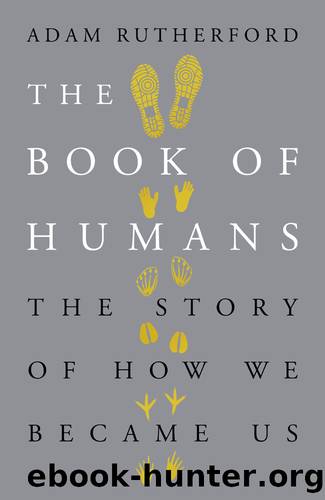The Book of Humans_The Story of How We Became Us by Adam Rutherford

Author:Adam Rutherford [Rutherford, Adam]
Language: eng
Format: epub
Tags: science, history
ISBN: 9780297609421
Google: OQRVDwAAQBAJ
Goodreads: 39939050
Publisher: Orion
Published: 2018-09-13T00:00:00+00:00
The giraffeâs recurrent laryngeal nerve
Giraffes tend to segregate by sex most of the time. The necking behaviour happens almost exclusively in male herds. In one report, recording more than 3,200 hours of observation over three years in national parks in Tanzania, sixteen male-on-male mountings were seen, nine of which featured an unsheathed penis. The naturalists assumed initially that this was an expression of dominance, but saw no activity (normally indicated by submission, or a particular posture) surrounding the act that supported that idea. In the same period, they only saw one male mount a female. Sixteen out of seventeen is about 94 per cent.
We donât know why they behave like this. Twenty-two calves were born in the same period, presumably following heterosexual action, so it follows that most mountings must have gone unobserved, but that also implies that more same-sex male mountings also happened. This data and other observations suggest that male giraffes donât have sex with females very often. When they do, they lick and smell the urine of the female, and then follow her around for a couple of days. The females will repeatedly frustrate the attempted mount by a male via the impressively nonchalant tactic of simply walking forwards. They eventually stand still if they are in the mood.
Even with scientific caution in play, it seems safe to say that most giraffe sexual encounters are male homosexual. Logic dictates that a species that is exclusively homosexual will not survive for very long. However, one in ten is still enough for a species to continue, and indeed twenty-two calves born in a three-year period is a decent brood. Female giraffes appear to be fertile and receptive for only a couple of days a year, and with a gestation period of up to one and a quarter years, theyâre not particularly prone to a quick generational turnaround. The homosexual encounters are clearly an activity that has some social meaning, though itâs not obviously the establishment of a hierarchy or dominance. We donât know much more than that.
Many other animals also engage in homosexual sex, including rats, elephants, lions, macaques, and at least twenty species of bat. There are fewer documented examples of female homosexuality, but then there is much less data on female sexuality in humans and other animals in general. As with so many areas of science, there has been a historical skew towards understanding male behaviour. Of the sapphic relations we do know about, we have a better understanding of biological principles that might be at work. Farmers are entirely untroubled by homosexual activity in goats, sheep, chickens, and even use cows mounting each other as a good sign that they are fertile. Whiptail lizards can reproduce using parthenogenesis, the virgin birth that we also see in Komodo dragons, and female-on-female mounting may be a mechanism to induce ovulation. Like bonobos, hyenas live in a matriarchy. Females are dominant, more aggressive and more muscular than males. They also have an unusual set of genitalia: the clitoris is huge, erectile and only slightly smaller than the male penis.
Download
This site does not store any files on its server. We only index and link to content provided by other sites. Please contact the content providers to delete copyright contents if any and email us, we'll remove relevant links or contents immediately.
The Environmental and Genetic Causes of Autism [2016] by James Lyons-Weiler(786)
Lifespan: Why We Age—and Why We Don't Have To by David A. Sinclair & Matthew D. LaPlante(783)
Blueprint by Robert Plomin(760)
Emperor of All Maladies A Biography of Cancer, The(737)
Genetics by Unknown(724)
Introducing Genetics (Introducing...) by Steve Jones(638)
Mercies in Disguise by Gina Kolata(631)
The Mansion of Happiness by Jill Lepore(628)
Britain's DNA Journey by Alistair Moffat(623)
The Lost Family by Libby Copeland(593)
Gene Cloning and DNA Analysis by Brown T. A.;(586)
The New Eugenics by Judith Daar(560)
Junk DNA by Carey Nessa(531)
Eugenics and Other Evils by G. K. Chesterton(517)
Medical Genetics by G. Bradley Schaefer(506)
The Compatibility Gene by Davis Daniel M(474)
The Genetic Strand by Edward Ball(459)
The Murder of Nikolai Vavilov by Peter Pringle(450)
Essential Genetics and Genomics by Hartl Daniel L.;(441)
